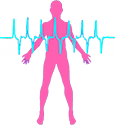
QEEG Brain Mapping
(Adapted from the Crossroads Institute)
QEEG Brain Mapping is a procedure that records electrical activity within the brain from 24 channels. This tool gives us the ability to view the dynamic changes taking place throughout the brain during processing tasks and assist in determining which areas of the brain are fully engaged and processing efficiently.
A Quantitative EEG or QEEG Brain Mapping provides information about the functional organization and disorganization of the brain and its normal development. It serves as a basis for identifying variations in brain function that are associated with different types of neurological disorders including Attention Deficit Disorder, Learning Disabilities, Depression, Dementia, Mild Head Injury and Obsessive/Compulsive Disorder, as well as assuring that the true underlying cause of the problem is addressed.
The QEEG Brain Mapping received FDA approval [510(k) 974748] as a diagnostic tool and presently is the only objective measure for many of these neurologically based disorders. This process is used in select hospitals, clinics and research centers around the world. At CBBT we use this more objective, accurate and detailed information to create more effective neurodevelopmental training protocols. This brain map provides us a baseline to work from while we retrain the brain.
**Analysis and treatment protocol recommendations of all QEEG brain maps administered at CBBT are completed by Joel Lubar, Ph.d (a pioneer in the field of EEG Biofeedback).**
Electrical Activity
The electrical activity of the brain behaves like any other electrical system. Changes in membrane polarization, inhibitory and excitatory post synaptic potentials, action potentials etc. create voltages that are conducted through the brain tissues. These electrical voltages enter the membranes surrounding the brain and continue up through the skull and appear at the scalp which are measured as microVolts. These potentials are recorded by an electrode that is attached to the scalp with non-toxic conductive gel. The electrodes are fed into a sensitive amplifier.
At CBBT the EEG is recorded from many electrodes arranged in a particular pattern. The pattern we use is the international 10/20 standard for describing these positions.
The “10-20 System” of Electrode Placement
The 10-20 system is based on the relationship between the location of an electrode and the underlying area of cerebral cortex.Each point on this figure to the left indicates a possible electrode position. Each site has a letter (to identify the lobe) and a number or another letter to identify the hemisphere location.
The letters F, T, C, P, and O stand for Frontal, Temporal, Central, Parietal and Occipital. (Note that there is no “central lobe”, but this is just used for identification purposes.) Even numbers (2,4,6,8) refer to the right hemisphere and odd numbers (1,3,5,7) refer to the left hemisphere. The z refers to an electrode placed on the midline.

What are we looking for?
The Stuck Brain vs Normal Functioning Brain
Symptoms such as attention and focus problems, learning and memory difficulties, and mood disorders (anxiety and depression) often occur when our brain’s processing ability is dysfunctional or damaged. We often find that its ability to function efficiently is inadequate to do the required or desired job.
Based upon the brain’s natural ability to adapt, a damaged brain will attempt to survive by releasing neuro-inhibitors to protect it’s limited resources. In doing so it locks itself into a particular electro-chemical pattern in order to not make matters worse. When this happens, we find ourselves losing attentional flexibility which reduces our ability to adapt to varying circumstances.
Our personality generally becomes rigid as well as feelings of there being no solutions to our problems. This is often the root of an overwhelming sense of helplessness, hopelessness and tends to drives us to mood extremes, such as depression, anger and even uncontrollable rage. Life generally is not fun or appealing.
How to Read the Brain Map
Measurement with Neurometrics
Each QEEG is compared to a normative database (Neuro Guide) that displays the EEGs of normal brain functioning individuals with your brain waves. Using this analysis tool the neurotherapist has at their disposal a sound, objective measure to help determine what is the possible source of symptoms. This is especially true with those sensitive to psychiatric illnesses, often characterized by disturbances of brain organization rather than brain structures.
Each Brain Map report includes extensive statistical tables of univariate and multivariate measures of absolute power and relative power, power asymmetry and synchronization (coherence), and color-coded topographic brain maps. This data is used to help identify normal and abnormal brain electrical activity. Selected EEG features from across different brain regions quantify the organization within the brain to identify disturbances in brain processing.
The Specifics
How are the tables used?
When we are considering a set of symptoms from a brain processing point of view, the contribution of each brain wave dysfunction can often be quite revealing. For example : When we are considering focal slow waves (delta waves) we generally will find them at the root of many learning difficulties.
For example, in those with Dyslexia, slow brain wave activity can be found in one or more key areas. This can include the occipital lobes at the back of the brain, where incoming visual information is received and processed, Wernicke’s area located in the left Parietal lobe, where the brain processes words for understanding; Broca’s area located in the left Frontal lobe, where words are put together for expression; and often in the sensorimotor area, where speech is converted from a feeling for verbalization of thoughts.


Map above shows baseline brain map of six year old child with a learning disability. Map below indicate improvements made one year later.
Our brain uses its 8 -13 cycles per second Alpha waves to idle itself, to rest areas not actively processing and acting on incoming sensory and motor information. While this idling is a normal and favorable phenomenon for the idling brain, if Alpha wave activity becomes “locked” and inhibited, active participation of vital brain areas cannot occur with efficiency. The frontal lobes are the areas most commonly affected by excessive (flooding) and non-reactive(inhibited) Alpha waves. Our brain uses its frontal lobes to focus attention outside itself and to understand the complexities of the world. It is not unusual to find high amplitude, frontal Alpha in those failing academically and those having trouble meeting job demands.
To process incoming information that requires us to think and act consciously, our brain uses Beta waves. As a fast brain wave frequency it energize specific areas in the cortex. If Beta is deficient, either all over or in small areas, the brain may have insufficient energy to perform classroom or workplace tasks at peer group standards. Keep in mind, there is no one brain wave pattern seen in all of those with a specific disease, disorder, or inefficiency. The QEEG in those with Attention Deficit Disorder, for example, may show high amplitude Delta slow waves, excessive Theta activity, or a locked in Alpha state.
Excessive Alpha and Beta brain activity is also the brain’s most reliable signature for depression, a common side effect of Learning Disabilities. Those with depression may show high Alpha or Beta, excessive coherence problems, or poor communication between the left and right frontal lobes.
Clinical symptoms of many disorders are often similar in many forms of brain processing related dysfunctions. Without the QEEG, it is almost impossible to differentiate what is what. It is the QEEG that helps the Neurotherapist sort out what is causing the symptoms in any particular individual.
What do the Tables Mean?
Brain processing problems often revealed themselves in the QEEG in one or more of the following brain wave categories:
Absolute Power – How much Brainpower is Available?
Absolute Power measurement aids the Neurotherapist in determining whether enough brainpower within a particular frequency range is present at each recording site.
Relative Power – Who’s In Charge Here?
The Relative Power measurement aids the Neurotherapist in determining whether a particular frequency is overpowering other vital brain frequencies.
Mean Frequency – Are they within Spec?
Each frequency band is measured between specific ranges. The average frequency tells us whether or not that specific bandwidth is operating within normal ranges. For example the alpha frequency is measured between 8hz and 13hz. It should peak around 10 hz. Often when we observe it peaking at 9.5hz and below, we observe individuals being tired, error prone or simply misunderstanding vital input information.
Ratios – Relationships are extremely important!
Relationships between the various brain frequencies are compared to those individuals with normal brain functioning. Ratios lower or higher than normal are a sign of inefficiency, in either the brain’s ability to process incoming information, or of attending to and executing specific tasks.
Asymmetry – The Brain’s Balancing Act.
Asymmetry scores reveal to us whether the brain waves between the various parts of the brain are balanced. Excessive activity may indicate an overtiring of brain cells. Insufficient activity may suggest brain cells are not firing sufficiently to maintain proper brain function.
Coherence – Who’s Talking to Whom?
In order for us to understand the complexity of the world and to make and execute decisions the different parts of the brain must share information. Coherence is one of the measurements on how well the brain is able to perform this inner self-talk. This measure gives us an indication of how efficiently our brain is working to connects and disconnects different parts of itself to accomplishes a particular task.Excessive Coherence tends to indicate two or more areas of the brain are “overly connected or locked together.” That is, the brain has become overly dependent on those centers and is not efficiently processing and executing information. This tends to result in poor day-to-day performance.
Deficient Coherence is the EEG sign of a brain not able to efficiently connect cortical areas to perform specific tasks. Learning Disabilities may show either (or both) excessive and deficient Coherence characteristics; serious traumatic brain injury classically results in excessive Coherence.
Phase – Tortoise or the Hare?
Many of the brain’s functions are timed events, the energy from one part of the brain arriving at another area at just the right moment to perform a specific task. The QEEG measurement is called Phase. Excessive Phase statistics mean the signals arrive too early; deficient, too late. In either case, the brain is not able to do its job with peak efficiency.
